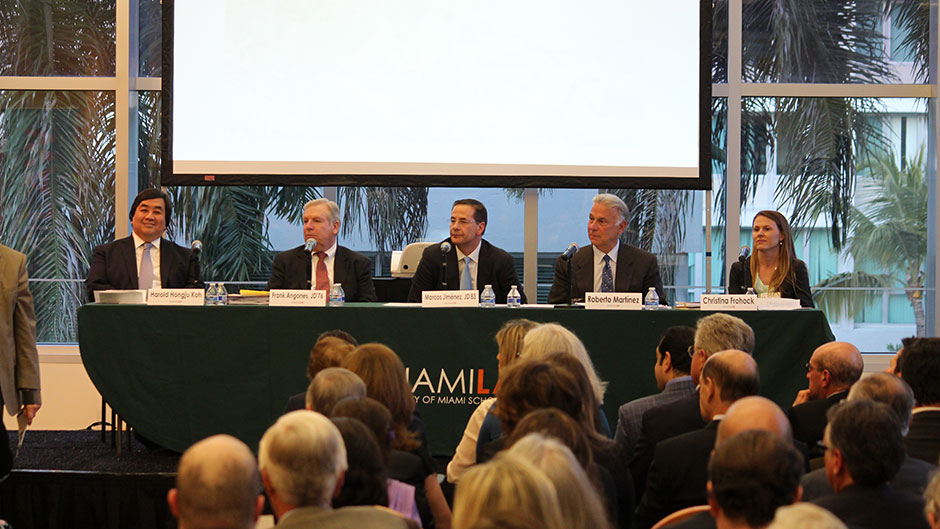Inside the event program, the list was long. In two columns, alphabetized from A to W.
They were the names of women and men, lawyers all, who had helped fight for legal rights of Cuban rafters and Haitians held at the U.S. Naval Base at Guantanamo Bay, Cuba, in the mid-1990s.
“They are my brothers- and sisters-in-law,” quipped fellow lawyer Harold Hongju Koh.
Many on the list were among the more than 100 people who turned out Monday night at the University of Miami’s Richter Library to hear a panel discussion about the refugee’s plight and the legal fight to win their freedom.
The lead lawyers in the case, Cuban American Bar Association v. Secretary of State Warren Christopher, outlined their strategy to secure representation of the 33,000 rafters, and the two year battle it took to get them freed and brought to the United States.
Joining Koh, a professor at Yale Law School, were Roberto Martinez, adjunct professor at UM’s School of Law and partner at Colson Hicks Eidson; Marcos Jimenez, a partner at McDermott Will & Emery LLP; and Francisco Angones, senior partner at Angones McClure & Garcia. The panel was moderated by Christina M. Frohock, a professor at the School of Law.
The panelists talked about how Haitians began being held at Guantanamo in the early 1990s, but it was in August 1994, Jimenez said, that “Fidel did what Fidel always did” when he wanted to get rid of dissidents – anyone who wanted to go could go.
The mass exodus began, and Cubans in boats, rafts, inner tubes and other makeshift craft fled across the Florida Strait. Some died at sea. About 8,000 made it to South Florida. More than 33,000 were intercepted by the U.S. Coast Guard and brought to Guantanamo.
The lawyers, all working for free, fought the U.S. government for due process rights for the detainees, and sought a solution that didn’t involve sending the group back to Cuba.
They recalled racing against time to file briefs in the case; being applauded by onlookers as they exited cars in front of the courthouse; winning the right to go and meet with rafters at the base; and one day being quoted in a front page article in USA Today.
“We embarked on this without really knowing anything about international law or human rights law,” recounted Angones. “It was a very emotional case for all of those involved.”
Martinez said the initial intent was not to win the lawsuit. The objective was to get the rafters freed and brought to the U.S., and the “lawsuit was a tool” used to make that happen.
The lawyers wanted sympathetic clients, people the public could rally behind. At Guantanamo they found a young woman who played the Star Spangled Banner on a violin, and her picture ended up in the Miami Herald. They found a pregnant woman among the detainees.
The detainees were held in a camp with barbed wire fencing. Many were educated – lawyers, doctors, teachers. Some were political prisoners in Cuba. They were all grateful for the intervention and representation.
At the conclusion of the discussion, Frohock and the panelists talked about how the detainment of the rafters and Haitians was a prelude to use of Guantanamo as a place to imprison suspected terrorists following 9/11.
The politics of the time, said Koh, gave the impression that Guantanamo was “the land without law.”
Peter Howard can be reached at 305-284-8085.
Law and Politics
People and Community

Home for Rafters and Combatants

Panelists included (l-r) Harold Hongju Koh, Francisco Angones, Marcos Jimenez, Roberto Martinez, and Christina Frohock.
